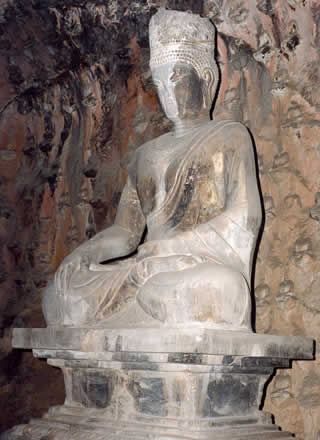 The Crowned Buddha at the Leigutai Nandong |
| The Longmen Grottoes, or Dragon Gate Grottoes,
are located near Wei Shui in the suburbs of Louyang. From the Northern Wei
to the Tang Dynasty, people, including various emperors, carved out this
large group of grottoes that is among the most famous in China. This exhibition,
timed to commemorate the addition of the grottoes to UNESCO’s World
Heritage sites, will be undertaken with the cooperation of the Longmen Grottoes
Research Institute. This exhibition will give a general survey of the Buddhist sculptures from the Northern Wei to the Tang Dynasty at Longmen Grottoes. Certain works, such as the crowned Buddha from the Leigutai Nandong, will be exhibited for the first time outside of China. In addition, the Buddhas excavated from the ruins of Fengxian si Temple, one of the ten temples at Longmen, where Jingangzhi Sancang is buried will be shown. |
| The Longmen Grottoes | ||
| Louyang is called “the old capital
of nine dynasties.” It is located in a wide basin and can only be reached
by a narrow road running along the river or through the mountains. Since
the capital of the Chou Dynasty was established there in 770 BC, to defend
it from invasion, a total of nine dynasties, including the Northern Wei,
Sui and Tang, were located in the region. From the city of Louyang, it takes
about 30 minutes by car to arrive at the Longmen Grottoes. The area where
Wei sui going through out from the narrow place called Yique, there are
grottoes on both the east and west banks. The southern grotto, Leigutai
Nandong, is positioned on the eastern bank. From the time the capital was moved to Louyang during the Northern Wei Dynasty (494 AD), a stone Buddha was carved in the mountainside out of limestone. The grotto runs several hundred meters along the river. Within it there is a small grotto where monks are said to have trained and another in which a stone Buddha was carved in relief. |
||
|
 |
|
 View of Longmen Grottoes from the eastern bank of Wei Shui |
||